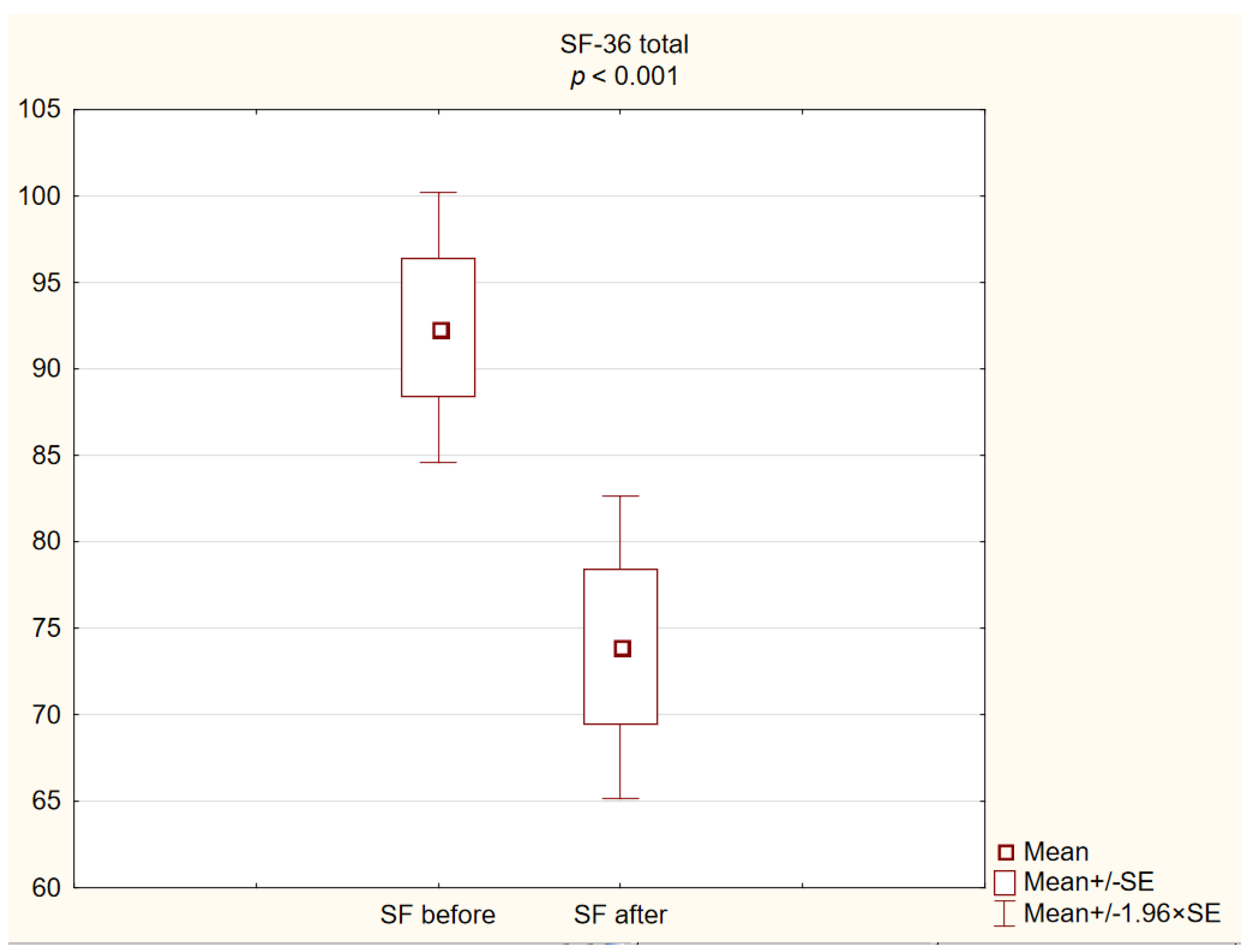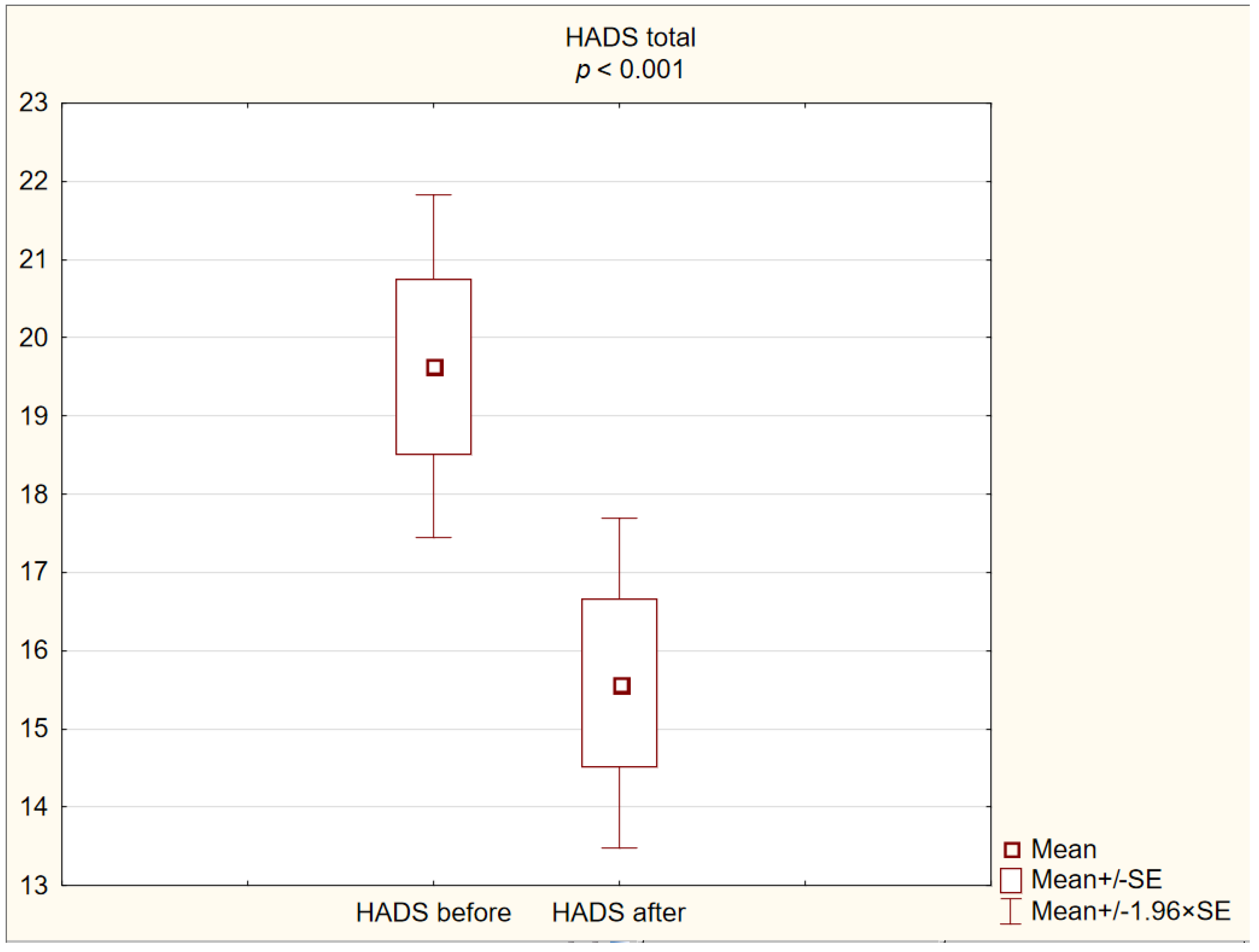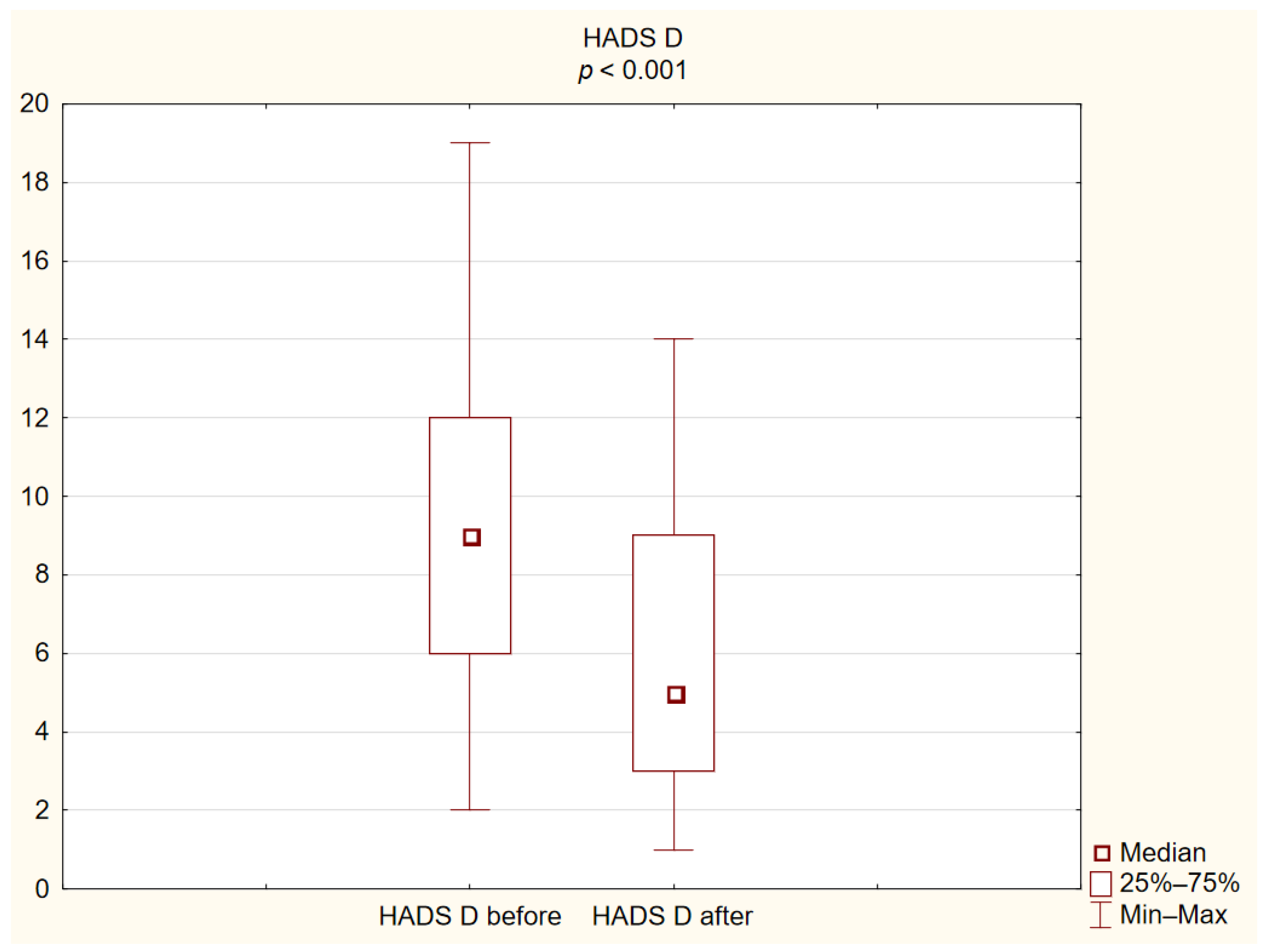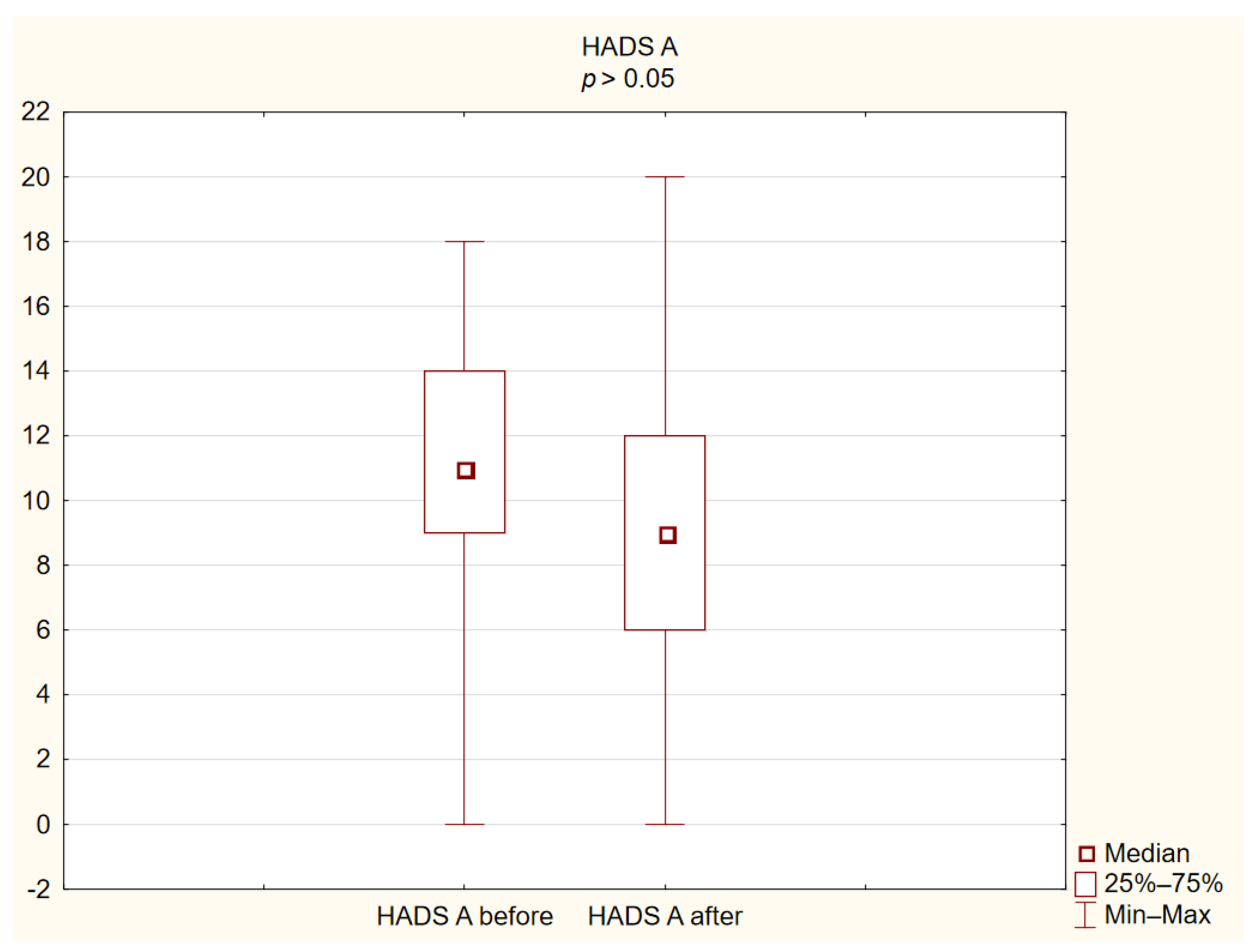Psychiatric Rehabilitation Amidst COVID-19: Do Pandemic Restrictions Affect the Therapeutic Efficiency?
Abstract
1. Introduction
2. Materials and Methods
3. Results
4. Discussion
5. Conclusions
6. Implications for the Future
Author Contributions
Funding
Institutional Review Board Statement
Informed Consent Statement
Data Availability Statement
Acknowledgments
Conflicts of Interest
References
- Veazie, S.; Lafavor, B.; Vela, K.; Young, S.; Sayer, N.; Carlson, K.; O’Neil, M. Mental health outcomes of adults hospitalized for COVID-19: A systematic review. J. Affect. Disord. Rep. 2022, 8, 100312. [Google Scholar] [CrossRef]
- Markiewicz-Gospodarek, A.; Górska, A.; Markiewicz, R.; Chilimoniuk, Z.; Czeczelewski, M.; Baj, J.; Maciejewski, R.; Masiak, J. The Relationship between Mental Disorders and the COVID-19 Pandemic—Course, Risk Factors, and Potential Consequences. Int. J. Environ. Res. Public Health 2022, 19, 9573. [Google Scholar] [CrossRef] [PubMed]
- Ahmed, G.K.; Khedr, E.M.; Hamad, D.A.; Masherf, T.S.; Hashem, M.M.; Aly, M.M. Long term impact of COVID-19 infection on sleep and mental health: A cross-sectional study. Psychiatry Res. 2021, 305, 114243. [Google Scholar] [CrossRef] [PubMed]
- Ahmed, J.O.; Ahmad, S.A.; Hassan, M.N.; Kakamad, F.H.; Salig, R.Q.; Abdulla, B.A.; Fattah, F.H.R.; Mohammed, S.H.; Ali, R.K.; Salig, A.M. Post COVID-19 neurological complications: A meta-analysis. Ann. Med. Surg. 2022, 76, 103440. [Google Scholar] [CrossRef] [PubMed]
- Dai, X.J.; Shao, Y.; Ren, L.; Tao, W.; Wang, Y. Risk factors of COVID-19 in subjects with and without mental disorders. J. Affect. Disord. 2022, 297, 102–111. [Google Scholar] [CrossRef]
- Santini, Z.I.; Jose, P.E.; York Cornwell, E.; Koyanagi, A.; Nielsen, L.; Hinrichsen, C.; Meilstrup, C.; Madsen, K.R.; Koushede, V. Social disconnectedness, perceived isolation, and symptoms of depression and anxiety among older Americans (NSHAP): A longitudinal mediation analysis. Lancet Public Health 2020, 5, e62–e70. [Google Scholar] [CrossRef] [PubMed]
- Cacioppo, J.T.; Hawkley, L.C.; Crawford, L.E.; Ernst, J.M.; Burleson, M.H.; Kowalewski, R.B.; Malarkey, W.B.; Van Cauter, E.; Berntson, G.G. Loneliness and health: Potential mechanisms. Psychosom. Med. 2002, 64, 407–417. [Google Scholar] [CrossRef]
- Smolarczyk-Kosowska, J.; Szczegielniak, A.; Legutko, M.; Zaczek, A.; Kunert, Ł.; Piegza, M.; Pudlo, R. Assessment of the Impact of a Daily Rehabilitation Program on Anxiety and Depression Symptoms and the Quality of Life of People with Mental Disorders during the COVID-19 Pandemic. Int. J. Environ. Res. Public Health 2021, 18, 1434. [Google Scholar] [CrossRef]
- Zigmond, A.S.; Snaith, R.P. The hospital anxiety and depression Scale. Acta Psychiatr. Scand. 1983, 67, 361–370. [Google Scholar] [CrossRef] [PubMed]
- Czerwiński, S.K.; Mackiewicz, J.J.; Mytlewska, W.M.; Atroszko, P.A. Trafność czynnikowa, równoważność pomiaru i trafność kryterialna Szpitalnej Skali Lęku i Depresji w próbie polskich studentów. Psychiatr Psychol Klin. 2020, 20, 13–18. [Google Scholar] [CrossRef]
- Tylka, J.; Piotrowicz, R. Kwestionariusz oceny jakosci zycia SF-36- wersja polska. Kardiol. Polska 2009, 67, 1166–1169. [Google Scholar] [PubMed]
- Tylka, J. Formularz SF 36-dokoczenie dyskusji. Kardiol. Polska 2010, 68, 985. [Google Scholar]
- Galderisi, S.; Rucci, P.; Mucci, A.; Rossi, A.; Rocca, P.; Bertolino, A.; Aguglia, E.; Amore, M.; Bellomo, A.; Bozzatello, P.; et al. The interplay among psychopathology, personal resources, context-related factors and real-life functioning in schizophrenia: Stability in relationships after 4 years and differences in network structure between recovered and non-recovered patients. World Psychiatry 2020, 19, 81–91. [Google Scholar] [CrossRef]
- Harvey, P.D.; Strassnig, M. Predicting the severity of everyday functional disability in people with schizophrenia: Cognitive deficits, functional capacity, symptoms, and health status. World Psychiatry 2012, 11, 73–79. [Google Scholar] [CrossRef] [PubMed]
- Galderisi, S.; Rossi, A.; Rocca, P.; Bertolino, A.; Mucci, A.; Bucci, P.; Rucci, P.; Gibertoni, D.; Aguglia, E.; Amore, M. The influence of illness-related variables, personal resources and context-related factors on real-life functioning of people with schizophrenia. World Psychiatry 2014, 13, 275–287. [Google Scholar] [CrossRef]
- Mucci, A.; Galderisi, S.; Gibertoni, D.; Rossi, A.; Rocca, P.; Bertolino, A.; Aguglia, E.; Amore, M.; Bellomo, A.; Biondi, M. Factors Associated With Real-Life Functioning in Persons With Schizophrenia in a 4-Year Follow-up Study of the Italian Network for Research on Psychoses. JAMA Psychiatry 2021, 78, 550–559. [Google Scholar] [CrossRef]
- Salari, A.N.; Hosseinian-Far, A.; Jalali, R.; Vaisi-Raygani, A.; Rasoulpoor, S.; Mohammadi, M.; Rasoulpoor, S.; Khaledi-Paveh, B. Prevalence of stress, anxiety, depression among the general population during the COVID-19 pandemic: A systematic review and meta-analysis. Global Health 2020, 16, 57. [Google Scholar] [CrossRef]
- Neria, Y.; Sullivan, G.M. Understanding the mental health effects of indirect exposure to mass trauma through the media. JAMA 2011, 30, 1374–1375. [Google Scholar] [CrossRef]
- COVID-19 Mental Disorders Collaborators. Global prevalence and burden of depressive and anxiety disorders in 204 countries and territories in 2020 due to the COVID-19 pandemic. Lancet 2021, 398, 1700–1712. [Google Scholar] [CrossRef] [PubMed]
- Castellini, G.; Rossi, E.; Cassioli, E.; Sanfilippo, G.; Innocenti, M.; Gironi, V.; Silvestri, C.; Voller, F.; Ricca, V. A longitudinal observation of general psychopathology before the COVID-19 outbreak and during lockdown in Italy. J. Psychosom. Res. 2021, 141, 110328. [Google Scholar] [CrossRef]
- Rawtaer, I.; Mahendran, R.; Yu, J.; Fam, J.; Feng, L.; Kua, E.H. Psychosocial interventions with art, music, Tai Chi and mindfulness for subsyndromal depression and anxiety in older adults: A naturalistic study in Singapore. Asia Pac. Psychiatry 2015, 7, 240–250. [Google Scholar] [CrossRef] [PubMed]
- Crone, D.M.; O’Connell, E.E.; Tyson, P.J.; Clark-Stone, F.; Opher, S.; James, D.V. ‘Art Lift’ intervention to improve mental well-being: An observational study from U.K. general practice. Int. J. Ment. Health Nurs. 2013, 22, 279–286. [Google Scholar] [CrossRef] [PubMed]
- Hu, J.; Zhang, J.; Hu, L.; Yu, H.; Xu, J. Art Therapy: A Complementary Treatment for Mental Disorders. Front Psychol. 2021, 12, 686005. [Google Scholar] [CrossRef]
- Chiang, M.; Reid-Varley, W.B.; Fan, X. Creative art therapy for mental illness. Psychiatry Res. 2019, 275, 129–136. [Google Scholar] [CrossRef]
- Rapidly Escalating COVID-19 Cases Amid Reduced virus Surveillance Forecasts a Challenging Autumn and Winter in the WHO European Region. Available online: https://www.who.int/europe/news/item/19-07-2022-rapidly-escalating-covid-19-cases-amid-reduced-virus-surveillance-forecasts-a-challenging-autumn-and-winter-in-the-who-european-region (accessed on 19 July 2022).
- Dhabhar, F.S. Effects of stress on immune function: The good, the bad, and the beautiful. Immunol. Res. 2014, 58, 193–210. [Google Scholar] [CrossRef] [PubMed]
- D’Acquisto, F.; Hamilton, A. Cardiovascular and immunological implications of social distancing in the context of COVID-19. Cardiovasc Res. 2020, 116, e129–e131. [Google Scholar] [CrossRef] [PubMed]
- Toubasi, A.A.; AbuAnzeh, R.B.; Tawileh, H.B.A.; Aldebei, R.H.; Alryalat, S.A.S. A meta-analysis: The mortality and severity of COVID-19 among patients with mental disorders. Psychiatry Res. 2021, 299, 113856. [Google Scholar] [CrossRef] [PubMed]
- Nemani, K.; Li, C.; Olfson, M.; Blessing, E.M.; Razavian, N.; Chen, J.; Petkova, E.; Goff, D.C. Association of Psychiatric Disorders With Mortality Among Patients With COVID-19. JAMA Psychiatry 2021, 78, 380–386. [Google Scholar] [CrossRef]
- Beurel, E.; Toups, M.; Nemeroff, C.B. The bidirectional relationship of depression and inflammation: Double trouble. Neuron 2020, 107, 234–256. [Google Scholar] [CrossRef]




| Elements of the Rehabilitation Program before the Introduction of Sanitary Restrictions | Elements of the Rehabilitation Program after Modification due to Sanitary Restrictions |
|---|---|
| Psychiatric consultation | Psychiatric consultation |
| Psychoeducation | Psychoeducation |
| Education of families or | - |
| guardians | |
| Therapeutic community | - |
| Psychological | Psychological |
| examination | examination |
| Individual psychological | Individual psychological |
| therapy | therapy |
| Group therapy with | - |
| psychologist | |
| Soft skills training & | Soft skills training & |
| activization exercises | activization exercises |
| Relaxation | Relaxation |
| Individual psychotherapy | Individual psychotherapy |
| Morning gymnastics | - |
| (group) | |
| Respiratory and general | - |
| fitness training (group) | |
| Balance training (group) | - |
| Interval training | Interval training |
| (individual) | (individual) |
| Choreo therapy | - |
| Art therapy | Art therapy |
| Horticulo therapy | Horticulo therapy |
| Ludo therapy | - |
| Music therapy | Music therapy |
| Bibliotherapy | Bibliotherapy |
| Social skills training | - |
| Individual consultation | Individual consultation |
| with a social worker | with a social worker |
| Computer-based | Computer-based |
| cognitive training | cognitive training |
| Massage chair | Massage chair |
| Culinary training | - |
| The Inclusion Criteria | The Exclusion Criteria |
|
|
| Age | |||||
| N | Mean | SD | Median | Min. | Max. |
| 41 | 59.54 | 20.10 | 69 | 24 | 83 |
| Gender | |||||
| Female | Male | ||||
| 28 | 13 | ||||
| Diagnosis | |||||
| Organic disorder | Schizophrenia | Affective | Anxiety disorder | ||
| 21 | 8 | 8 | 4 | ||
| Education | Primary | Vocational | Secondary | Higher | |
| 2 | 5 | 22 | 12 | ||
| Marital status | |||||
| Single | Married | Divorced/separated | Widow/widower | Informal relationship | |
| 13 | 5 | 4 | 17 | 2 | |
| Place of residence | |||||
| Rural area/village | City; <100,000 inhabitants | City; 100,000–3,000,000 inhabitants | City; >300,000 inhabitants | ||
| 4 | 29 | 3 | 5 | ||
| Living conditions | |||||
| Living alone | Living with family | Social Welfare Home | Others | ||
| 16 | 19 | 1 | 5 | ||
| Professional activity | |||||
| Retirement | Sickness Benefit | Dependent on the family | Unemployed | Others | |
| 20 | 14 | 1 | 3 | 3 | |
| Smoking | |||||
| Yes | No | ||||
| 5 | 36 | ||||
| Comorbidities | |||||
| Hypertension | Diabetes | Diseases of the thyroid gland | Bronchial asthma | ||
| 11 | 8 | 6 | 2 | ||
| Variable | Median | Min. | Max. | IQR | Mean (SD) | t/Z | p |
|---|---|---|---|---|---|---|---|
| HADS D before | 9 | 2 | 19 | 6–12 | 9.17 (4.58) | 4.009Z | <0.001 |
| HADS D after | 5 | 1 | 14 | 3–9 | 6.17 (3.97) | ||
| HADS A before | 11 | 0 | 18 | 9–14 | 10.46 (4.06) | 1.773Z | 0.05 |
| HADS A after | 9 | 0 | 20 | 6–12 | 9.42 (4.24) | ||
| HADS before | 20 | 3 | 34 | 15–24 | 19.63 (7.16) | 4.081t | <0.001 |
| HADS after | 14 | 4 | 34 | 10–21 | 15.59 (6.90) | ||
| SF-36 before | 93 | 30 | 142 | 80–106 | 92.39 (25.57) | 4.855t | <0.001 |
| SF-36 after | 73 | 27 | 143 | 53–95 | 73.93 (28.58) |
Publisher’s Note: MDPI stays neutral with regard to jurisdictional claims in published maps and institutional affiliations. |
© 2022 by the authors. Licensee MDPI, Basel, Switzerland. This article is an open access article distributed under the terms and conditions of the Creative Commons Attribution (CC BY) license (https://creativecommons.org/licenses/by/4.0/).
Share and Cite
Smolarczyk-Kosowska, J.A.; Dębski, P.; Szczegielniak, A.R.; Piegza, M.; Pudlo, R. Psychiatric Rehabilitation Amidst COVID-19: Do Pandemic Restrictions Affect the Therapeutic Efficiency? Appl. Sci. 2022, 12, 11930. https://doi.org/10.3390/app122311930
Smolarczyk-Kosowska JA, Dębski P, Szczegielniak AR, Piegza M, Pudlo R. Psychiatric Rehabilitation Amidst COVID-19: Do Pandemic Restrictions Affect the Therapeutic Efficiency? Applied Sciences. 2022; 12(23):11930. https://doi.org/10.3390/app122311930
Chicago/Turabian StyleSmolarczyk-Kosowska, Joanna A., Paweł Dębski, Anna R. Szczegielniak, Magdalena Piegza, and Robert Pudlo. 2022. "Psychiatric Rehabilitation Amidst COVID-19: Do Pandemic Restrictions Affect the Therapeutic Efficiency?" Applied Sciences 12, no. 23: 11930. https://doi.org/10.3390/app122311930
APA StyleSmolarczyk-Kosowska, J. A., Dębski, P., Szczegielniak, A. R., Piegza, M., & Pudlo, R. (2022). Psychiatric Rehabilitation Amidst COVID-19: Do Pandemic Restrictions Affect the Therapeutic Efficiency? Applied Sciences, 12(23), 11930. https://doi.org/10.3390/app122311930







